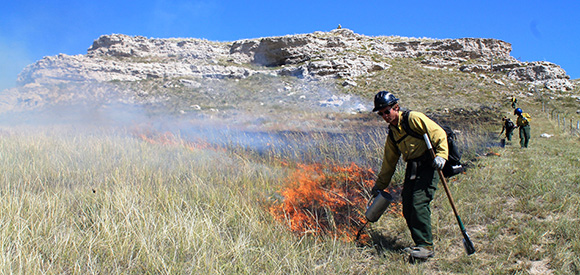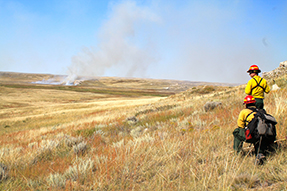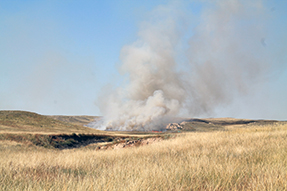Agate Fossil Beds National Monument conducted a prescribed fire in the mixed grass prairie and wetlands of the Niobrara River basin.
The area burned more thoroughly and evenly than I expected, especially south of the river, where thatch had been building up in the prairie grasses for 50 years. James Hill, Superintendent


On September 15, 2014, Agate Fossil Beds National Monument conducted a prescribed fire in the mixed grass prairie and wetlands of the Niobrara River basin. The goals of the approximately 670-acre burn were to decrease fuel loading and the presence of invasive plant species in and around the Niobrara River floodplain. Fire serves as a natural, and necessary, control on the buildup of live and decaying plant matter and the prevalence of invasive plants.
Wildland firefighters from the Nebraska National Forest (USFS), Wind Cave National Park, Black Hills Wildland Fire Module, Northern Great Plains Fire Management, Theodore Roosevelt National Park, Badlands National Park, Scotts Bluff National Monument (NPS), Lacreek National Wildlife Refuge (USFWS), and the Harrison, Nebraska, Volunteer Fire Department worked in concert to meet the objectives of the burn unit with an emphasis on public and firefighter safety, as well as protection of park infrastructure and cultural assets. Plot monitoring data one and two years after the burn will evaluate its effectiveness.

The mixed grass prairies at the park are home to a diverse variety of native grasses, sedges, wildflowers, cacti, and succulents. The riparian areas close to the Niobrara River are home to wetland plants such as cattail, foxtail barley, wild licorice, blue flag, and nonnative yellow Siberian iris.
Native wildlife that thrive in the prairie and riparian habitats at the park include many insects, at least 73 species of bird; 16 species of reptiles; amphibians such as leopard frog, Woodhouse’s toad, western chorus frogs, and salamanders; and mammals such as deer, antelope, coyote, swift fox, red fox, badger, mink, several species of bat, bobcat, and mountain lion.
The prairie and riparian ecosystems that support this diverse abundance of wildlife benefit from the natural effects of fire, which releases nutrients into the soil, invigorates native grasses and forbs, potentially decreases invasive plant cover, and aerates topsoil by removing layers of plant matter.
Park leadership and fire managers were pleased with the initial results of the burn, which reduced a substantial amount of fuel loading, giving native plants a better chance to thrive in the next growing season. The fire effects crew at Northern Great Plains Fire Management will monitor the burn area in the months and years to come to determine the effectiveness of the burn.
James Hill, superintendent of Agate Fossil Beds National Monument, said “The area burned more thoroughly and evenly than I expected, especially south of the river, where thatch had been building up in the prairie grasses for 50 years. This burn significantly reduced that fuel load. I’m very thankful to everyone for coming down, from the module, the parks, the USFS, USFWS, and Harrison Volunteer Fire Department to make the burn a success.”
Contact: Eric Allen, Northern Great Plains Fire Management Officer, eric_allen@nps.gov, (605) 745-1156
Last updated: December 13, 2016
